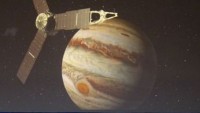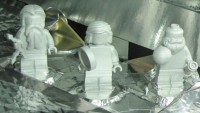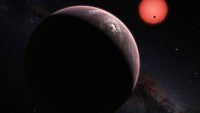First Images Ever of Jupiter’s North and South Poles Lead to Unique Discoveries
| Arthur Dominic Villasanta | | Sep 04, 2016 03:05 AM EDT |
(Photo : NASA/JPL-Caltech/SwRI/MSSS) This infrared image from Juno provides an unprecedented view of Jupiter's southern aurora. These views are not possible from Earth.
(Photo : NASA/JPL-Caltech/SwRI/MSSS) NASA's Juno spacecraft took this photo as it closed in on Jupiter's north pole, about two hours before closest approach on Aug. 27, 2016.
The first pictures sent by NASA's Juno spacecraft of Jupiter's North Pole depicts a planet unlike the ones we're used to seeing with its many bands of colored clouds and storms. Juno also picked-up "ghostly sounds" being emitted by the giant planet.
The stunning photos, including the first infrared views of Jupiter's north and south poles, were taken during the spacecraft's first flyby of the planet with its instruments switched on. Some unique discoveries have already made themselves visible.
Like Us on Facebook
"First glimpse of Jupiter's north pole, and it looks like nothing we have seen or imagined before," said Scott Bolton, principal investigator of Juno from the Southwest Research Institute in San Antonio.
"It's bluer in color up there than other parts of the planet, and there are a lot of storms. There is no sign of the latitudinal bands or zone and belts that we are used to -- this image is hardly recognizable as Jupiter. We're seeing signs that the clouds have shadows, possibly indicating that the clouds are at a higher altitude than other features."
One of the most notable findings of these first-ever pictures of Jupiter's north and south poles is something the JunoCam imager didn't see.
"Saturn has a hexagon at the north pole," said Bolton. "There is nothing on Jupiter that anywhere near resembles that. The largest planet in our solar system is truly unique. We have 36 more flybys to study just how unique it really is."
Juno successfully completed the first of 36 orbital flybys on Aug. 27 when the spacecraft was 4,200 kilometers above Jupiter's cloud tops. The download of six megabytes of data collected during the six-hour transit, from above Jupiter's North Pole to below its south pole, took one-and-a-half days.
All eight of Juno's science instruments were energized and collected data. The Jovian Infrared Auroral Mapper (JIRAM), supplied by the Italian Space Agency, acquired some remarkable images of Jupiter at its north and south polar regions in infrared wavelengths.
"JIRAM is getting under Jupiter's skin, giving us our first infrared close-ups of the planet," said Alberto Adriani, JIRAM co-investigator from Istituto di Astrofisica e Planetologia Spaziali, Rome.
"These first infrared views of Jupiter's north and south poles are revealing warm and hot spots that have never been seen before. And while we knew that the first-ever infrared views of Jupiter's south pole could reveal the planet's southern aurora, we were amazed to see it for the first time.
"No other instruments, both from Earth or space, have been able to see the southern aurora. Now, with JIRAM, we see that it appears to be very bright and well-structured. The high level of detail in the images will tell us more about the aurora's morphology and dynamics."
Among the more unique data sets collected by Juno during its first scientific sweep by Jupiter was that acquired by the mission's Radio/Plasma Wave Experiment (Waves) that recorded ghostly-sounding transmissions emanating from above the planet. These radio emissions from Jupiter have been known about since the 1950s but had never been analyzed from such a close vantage point.
"Jupiter is talking to us in a way only gas-giant worlds can," said Bill Kurth, co-investigator for the Waves instrument from the University of Iowa, Iowa City.
"Waves detected the signature emissions of the energetic particles that generate the massive auroras which encircle Jupiter's north pole. These emissions are the strongest in the solar system. Now we are going to try to figure out where the electrons come from that are generating them."
Juno was launched on Aug. 5, 2011, from Cape Canaveral, Florida and arrived at Jupiter on July 4, 2016. JPL manages the Juno mission for the principal investigator, Scott Bolton, of Southwest Research Institute in San Antonio. Juno is part of NASA's New Frontiers Program, which is managed at NASA's Marshall Space Flight Center in Huntsville, Alabama, for NASA's Science Mission Directorate. Lockheed Martin Space Systems, Denver, built the spacecraft. Caltech in Pasadena, California, manages JPL for NASA.
TagsJuno spacecraft, NASA, north pole, Scott Bolton, Jupiter
©2015 Chinatopix All rights reserved. Do not reproduce without permission
EDITOR'S PICKS
-

Did the Trump administration just announce plans for a trade war with ‘hostile’ China and Russia?
-

US Senate passes Taiwan travel bill slammed by China
-

As Yan Sihong’s family grieves, here are other Chinese students who went missing abroad. Some have never been found
-

Beijing blasts Western critics who ‘smear China’ with the term sharp power
-

China Envoy Seeks to Defuse Tensions With U.S. as a Trade War Brews
-

Singapore's Deputy PM Provides Bitcoin Vote of Confidence Amid China's Blanket Bans
-

China warns investors over risks in overseas virtual currency trading
-

Chinese government most trustworthy: survey
-

Kashima Antlers On Course For Back-To-Back Titles
MOST POPULAR
LATEST NEWS
Zhou Yongkang: China's Former Security Chief Sentenced to Life in Prison

China's former Chief of the Ministry of Public Security, Zhou Yongkang, has been given a life sentence after he was found guilty of abusing his office, bribery and deliberately ... Full Article
TRENDING STORY

China Pork Prices Expected to Stabilize As The Supplies Recover

Elephone P9000 Smartphone is now on Sale on Amazon India

There's a Big Chance Cliffhangers Won't Still Be Resolved When Grey's Anatomy Season 13 Returns

Supreme Court Ruled on Samsung vs Apple Dispute for Patent Infringement

Microsoft Surface Pro 5 Rumors and Release Date: What is the Latest?















